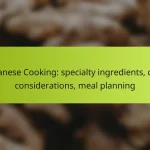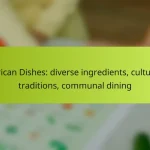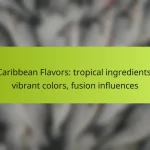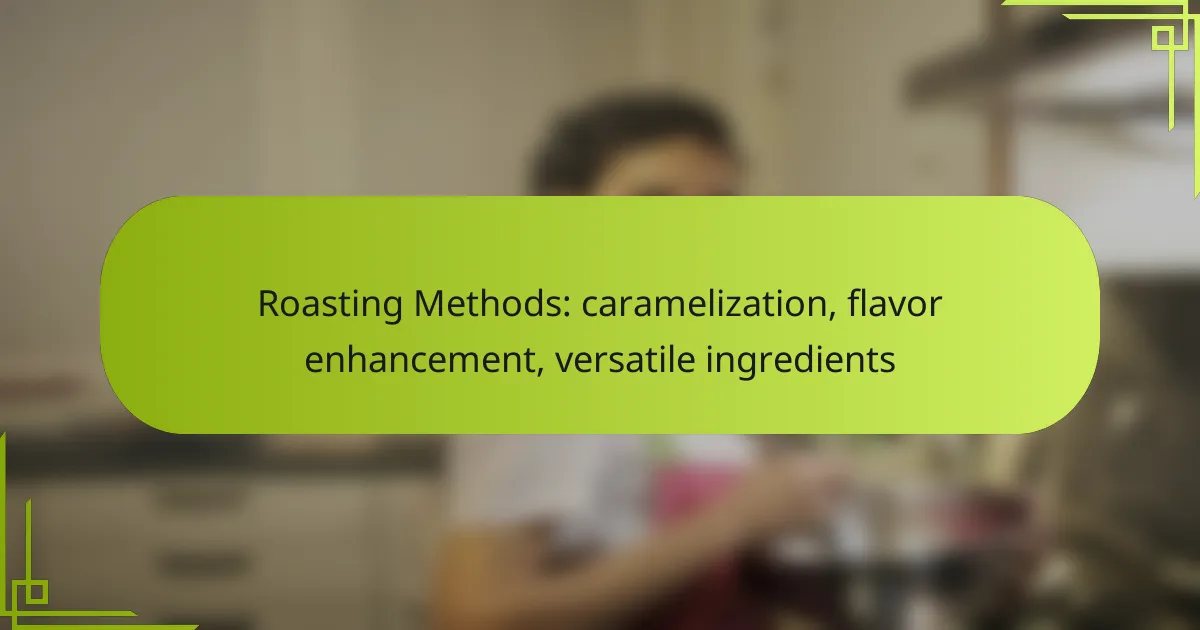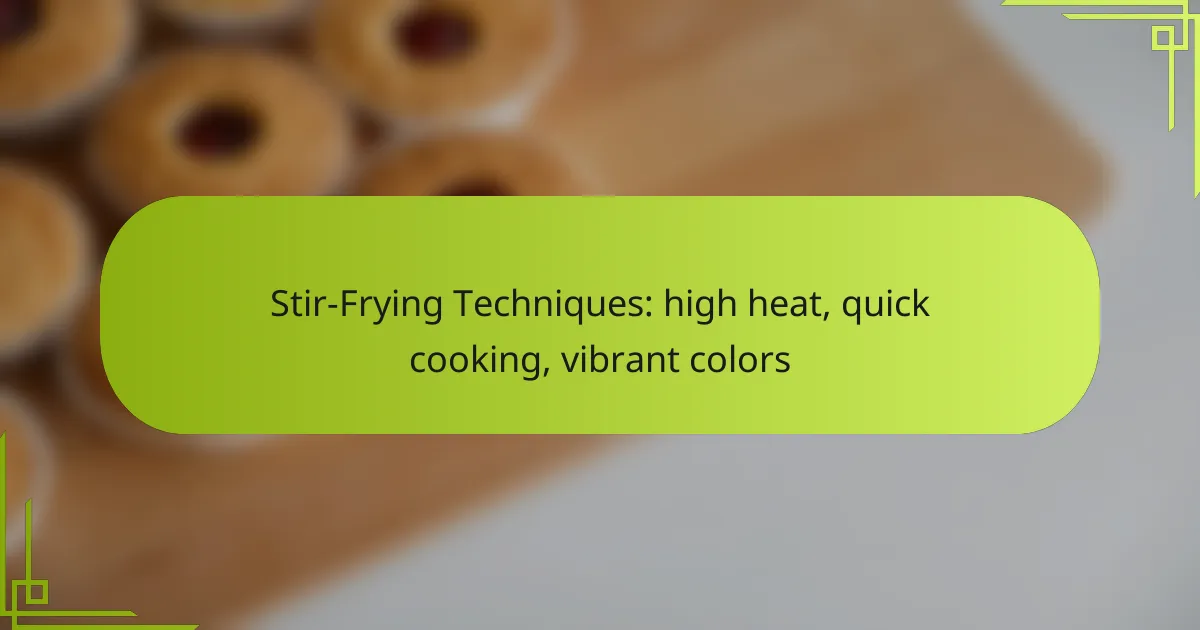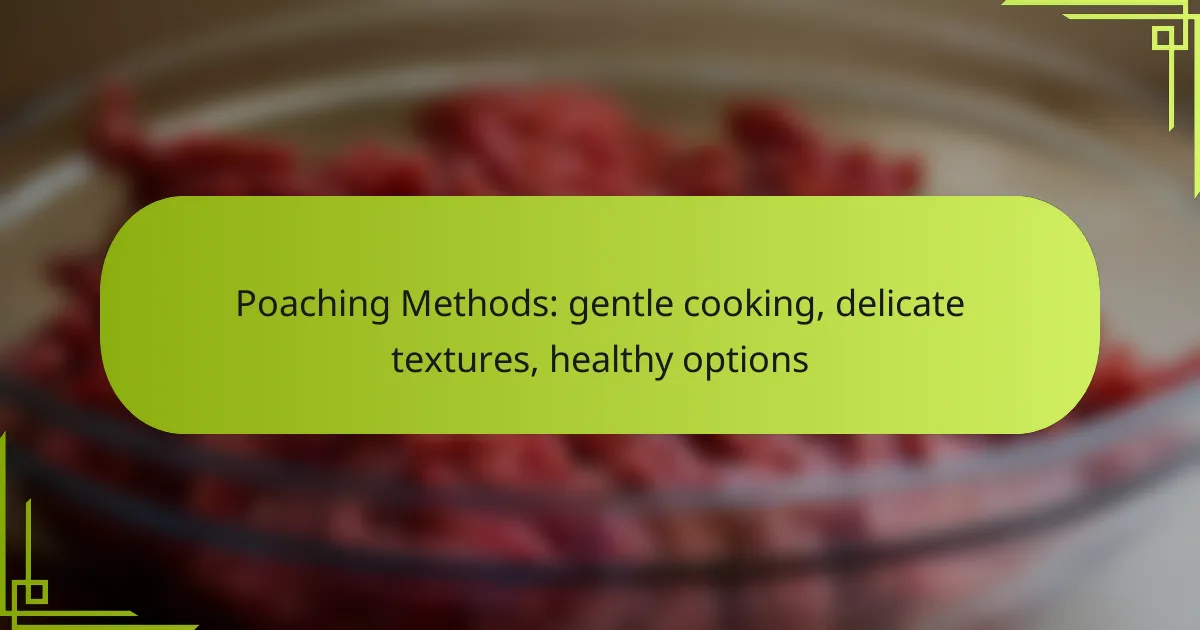Roasting methods play a crucial role in caramelization, enhancing the natural sugars in ingredients to create rich flavors and appealing colors. Techniques such as dry roasting, oven roasting, and grilling not only transform raw ingredients through chemical reactions but also develop depth and complexity in taste. This versatile cooking approach elevates a wide range of foods, from vegetables and nuts to meats and fruits, making them more delicious and enjoyable.

What are the best roasting methods for caramelization?
The best roasting methods for caramelization involve techniques that enhance the natural sugars in ingredients, resulting in rich flavors and appealing colors. Key methods include dry roasting, oven roasting, pan roasting, grilling, and smoking, each offering unique benefits and flavor profiles.
Dry roasting
Dry roasting involves cooking food without added fats, allowing the natural sugars to caramelize as the ingredients heat up. This method is ideal for nuts, seeds, and spices, enhancing their flavors while maintaining a crunchy texture.
To dry roast effectively, preheat your pan and add the ingredients in a single layer. Stir occasionally to ensure even cooking, and watch closely to prevent burning. Typically, this process takes about 5-10 minutes depending on the ingredient.
Oven roasting
Oven roasting uses dry heat to cook food evenly, making it suitable for a variety of vegetables and meats. This method allows for caramelization to occur over a longer period, resulting in deep flavors and a tender texture.
For optimal results, preheat the oven to a high temperature, around 400-450°F (200-230°C). Toss the ingredients with a small amount of oil and seasonings before roasting for about 20-40 minutes, depending on the size and type of food.
Pan roasting
Pan roasting combines stovetop cooking with oven finishing, making it a versatile method for meats and hearty vegetables. Start by searing the food in a hot pan to develop a crust, then transfer it to the oven to finish cooking and enhance caramelization.
This method typically requires a heavy skillet or cast iron pan. Sear the food for about 3-5 minutes per side before moving it to a preheated oven at 375°F (190°C) for an additional 10-20 minutes, depending on thickness.
Grilling
Grilling exposes food to direct heat, which promotes caramelization and adds a smoky flavor. This method works well for meats, vegetables, and fruits, creating appealing grill marks and enhancing sweetness.
Preheat the grill to medium-high heat, around 400°F (200°C). Oil the grill grates to prevent sticking, and cook the food for a few minutes on each side until caramelized and cooked through. Keep an eye on the food to avoid flare-ups.
Smoking
Smoking infuses food with rich flavors while promoting caramelization through low and slow cooking. This method is particularly effective for meats, fish, and even some vegetables, creating a unique taste profile.
Use a smoker or a grill set up for indirect heat with wood chips for flavor. Maintain a temperature around 225-250°F (107-121°C) and smoke the food for several hours, depending on the type and size of the ingredient. Monitor moisture levels to prevent drying out.
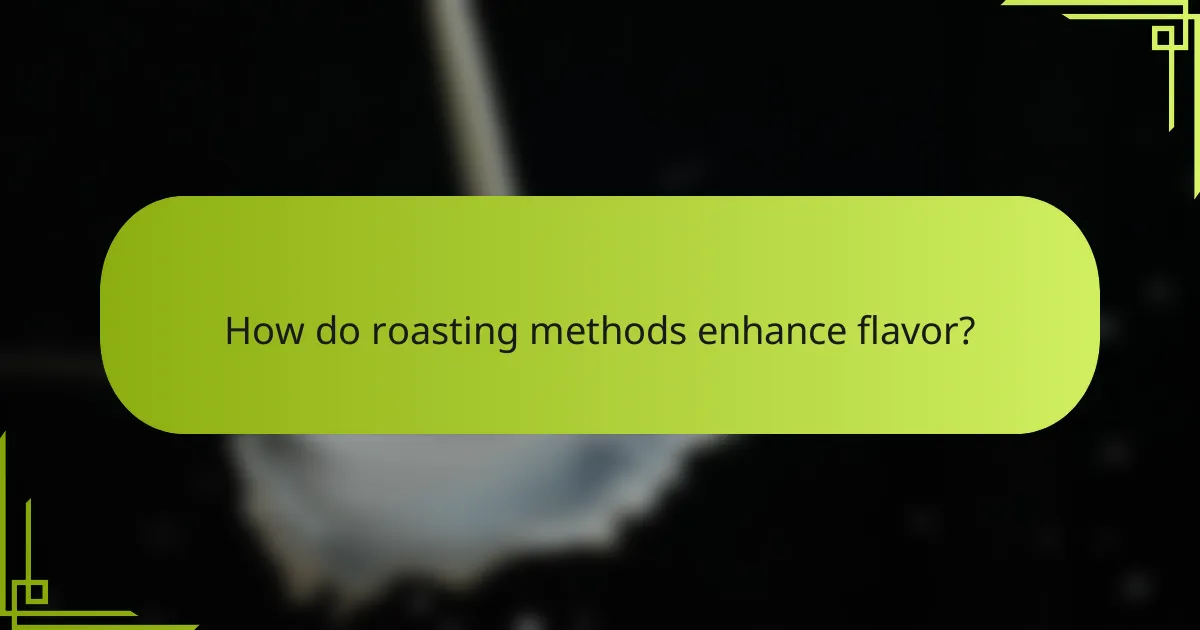
How do roasting methods enhance flavor?
Roasting methods enhance flavor by transforming raw ingredients through chemical reactions, resulting in richer tastes and aromas. Techniques like the Maillard reaction and the development of flavor compounds are key to achieving depth and complexity in roasted foods.
Maillard reaction
The Maillard reaction is a complex chemical process that occurs when proteins and sugars in food are exposed to heat, creating a range of flavorful compounds. This reaction typically begins at temperatures above 140°C (285°F) and is responsible for the browning of meats, bread crusts, and roasted vegetables.
To maximize the Maillard reaction, ensure even heat distribution and avoid overcrowding the cooking surface. For example, roasting a chicken at a high temperature can yield a crispy skin and savory flavor, while slow-roasting vegetables can enhance their natural sweetness.
Flavor compounds development
During roasting, various flavor compounds develop, contributing to the overall taste profile of the food. These compounds include volatile oils, acids, and phenols, which can change significantly based on the roasting time and temperature.
For instance, roasting coffee beans at different levels (light, medium, dark) produces distinct flavor notes, from fruity and acidic to rich and chocolatey. Experimenting with roasting times can help achieve the desired flavor intensity.
Texture improvement
Roasting not only enhances flavor but also improves texture by creating a contrast between crispy exteriors and tender interiors. This textural difference is appealing and adds to the overall eating experience.
For optimal texture, consider the size and type of ingredients. Larger cuts of meat may require longer roasting times to ensure the inside is cooked properly while achieving a crispy outer layer. Vegetables can be cut into uniform pieces to promote even cooking and browning.
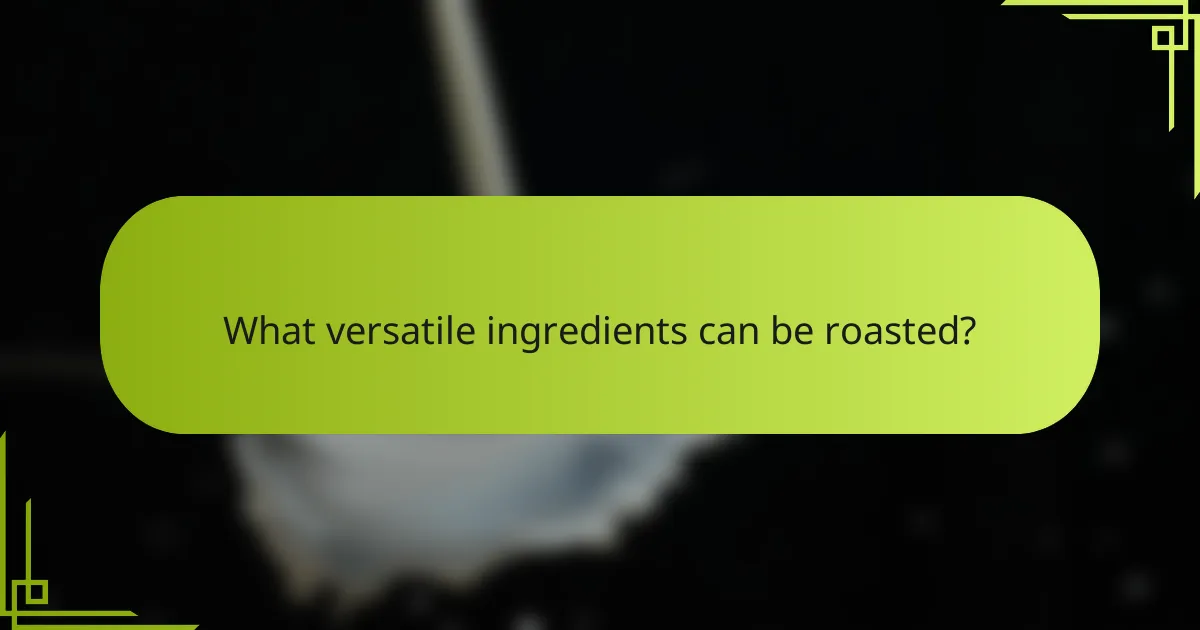
What versatile ingredients can be roasted?
Roasting enhances the natural flavors of various ingredients, making them more appealing and delicious. Commonly roasted items include vegetables, nuts, meats, and fruits, each offering unique textures and tastes when cooked this way.
Vegetables
Roasting vegetables caramelizes their natural sugars, resulting in a sweeter and more complex flavor profile. Common choices include carrots, bell peppers, and Brussels sprouts. Aim for even-sized pieces to ensure uniform cooking, typically at temperatures around 200-220°C (400-425°F) for 20-30 minutes.
To enhance flavor, toss vegetables in olive oil, salt, and pepper before roasting. Adding herbs or spices like rosemary or paprika can elevate the taste further. Avoid overcrowding the pan to allow proper browning.
Nuts
Nuts benefit from roasting by developing deeper flavors and crunchier textures. Almonds, walnuts, and pecans are popular options. Roast them at 160-180°C (325-350°F) for about 10-15 minutes, stirring occasionally to prevent burning.
Consider seasoning nuts with salt or spices before roasting for added flavor. Be cautious, as nuts can quickly go from perfectly roasted to burnt. Store roasted nuts in an airtight container to maintain freshness.
Meats
Roasting meats, such as chicken, beef, or pork, creates a savory crust while keeping the inside juicy. Use a roasting temperature of around 180-200°C (350-400°F) and cook until the internal temperature reaches safe levels, typically 75°C (165°F) for poultry and 63°C (145°F) for beef.
Season meats with herbs, garlic, and spices to enhance flavor. Basting with pan juices during cooking can keep the meat moist. Always let the meat rest after roasting to allow juices to redistribute for optimal tenderness.
Fruits
Roasting fruits like apples, pears, or peaches intensifies their sweetness and adds a caramelized exterior. Cut fruits into wedges or halves and roast at around 190-200°C (375-400°F) for 15-25 minutes, depending on the type and ripeness.
Drizzle fruits with honey or sprinkle with cinnamon before roasting for extra flavor. Roasted fruits can be served as a dessert or added to salads and savory dishes for a unique twist.

What criteria should be considered when choosing a roasting method?
When selecting a roasting method, consider the ingredient type, desired flavor profile, and cooking time. Each of these factors influences the final taste and texture of the roasted food, making it essential to align your method with your culinary goals.
Ingredient type
The type of ingredient significantly impacts the roasting method you should choose. For instance, vegetables often benefit from high-heat roasting to caramelize their natural sugars, while meats may require slower cooking to ensure tenderness. Consider the moisture content and density of the ingredient; denser items like root vegetables may need longer cooking times compared to lighter options like bell peppers.
Additionally, different ingredients may respond better to various roasting techniques. For example, nuts can be roasted quickly at moderate temperatures to enhance their flavor without burning, while larger cuts of meat may require a combination of high and low heat to achieve the desired doneness.
Desired flavor profile
Your desired flavor profile will guide your choice of roasting method. If you aim for deep, rich flavors, methods that promote caramelization, such as high-heat roasting, are ideal. Conversely, if you prefer a more subtle taste, consider using lower temperatures to allow for even cooking without excessive browning.
Experimenting with different roasting techniques can yield varied results. For instance, roasting with herbs and spices can infuse flavors into the food, while using a marinade before roasting can enhance moisture and taste. Keep in mind that the choice of fat, such as olive oil or butter, can also affect the final flavor.
Cooking time
Cooking time is a critical factor when selecting a roasting method. Generally, larger cuts of meat require longer roasting times, often ranging from one to several hours, depending on the size and type. Vegetables, on the other hand, typically roast in a shorter time frame, often between 20 to 45 minutes.
To ensure even cooking, consider the size and cut of your ingredients. Cutting vegetables into uniform pieces can help them roast evenly and more quickly. Use a meat thermometer for meats to check for doneness, as this can prevent overcooking and ensure the best texture and flavor.

What are the emerging trends in roasting methods?
Emerging trends in roasting methods focus on enhancing flavor through innovative techniques and versatile ingredients. These methods prioritize caramelization and flavor enhancement, allowing for a more dynamic culinary experience.
Caramelization
Caramelization is a crucial process in roasting that transforms sugars into complex flavors and aromas. This occurs when ingredients are exposed to high heat, typically between 320°F and 350°F (160°C to 180°C), resulting in a rich, golden-brown color and a sweet, nutty taste. Understanding the right temperature and timing is essential to achieve optimal caramelization without burning.
For example, vegetables like carrots and onions benefit significantly from caramelization, enhancing their natural sweetness. Aim for a roasting time of around 25-35 minutes, turning occasionally to ensure even browning.
Flavor Enhancement
Flavor enhancement in roasting involves using various techniques and ingredients to elevate the overall taste profile of the dish. This can include marinating proteins beforehand, using spices, or incorporating fats like olive oil or butter to promote browning and depth of flavor. A well-seasoned roast can significantly improve the final dish.
Consider using herbs such as rosemary or thyme, which can infuse their flavors into meats and vegetables during the roasting process. A common practice is to season generously with salt and pepper before roasting, allowing the flavors to penetrate the ingredients.
Versatile Ingredients
Versatile ingredients are those that can be used across various roasting methods, providing flexibility in meal preparation. Common examples include root vegetables, poultry, and fish, which can be adapted to different flavor profiles and cooking techniques. This adaptability allows for creativity in the kitchen.
When selecting ingredients, consider seasonal produce for the best flavor and freshness. For instance, using squash in the fall or asparagus in the spring can enhance the dish’s appeal. Aim to combine different textures and flavors, such as pairing tender chicken with crunchy Brussels sprouts, to create a balanced and satisfying meal.


